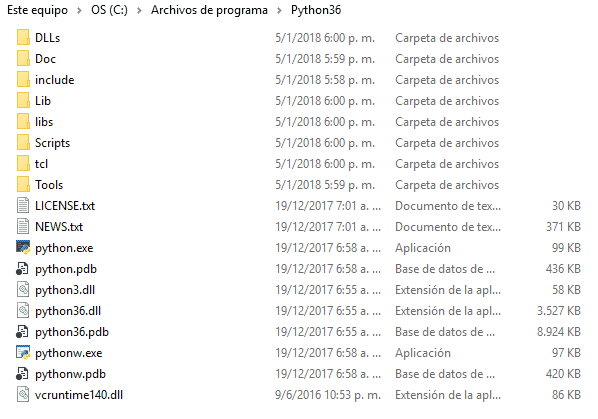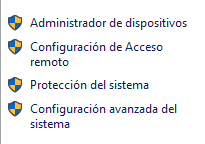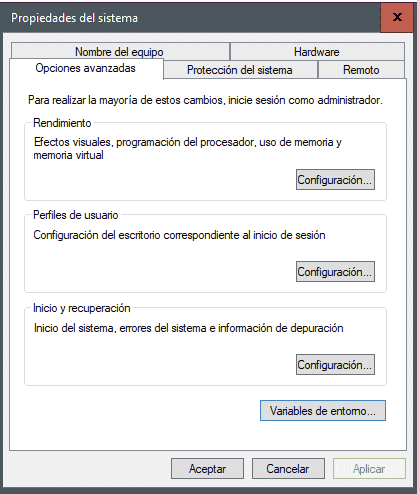Getting Started with Python: Why Python?, Installation and Configuration
Python is an interpreted programming language, which means that it does not need to be compiled and it does not generate an executable as in the case of many other programming languages such as Java, it is cross-platform and supports object-oriented programming.
In this first Python entry we will talk about Python, some of its features, advantages, installation and configuration to get everything ready to start working with Python; but before that we'll talk a bit about why work with Python.
The incredible growth of Python in recent years
Python is a programming language that has experienced enormous growth in recent years, as we can see in the following graph:

Image via Stack Overflow
As you can see, Python has only grown and there is nothing like learning something new that is currently very popular and will surely continue to be so in the future.
Why Python?
Python for everything: web apps, desktop, cross-platform and portable
Python is not a language with which we can only develop for the Web using one of the many frameworks such as Django, among many others that exist:
Web Frameworks for Python
We can also use it to develop cross-platform desktop applications for Windows, Mac and of course Linux; which brings us to the fact that Python is portable between all these platforms.
Multiplatform and more than 127,000 libraries
Python has more than 127,000 libraries in its official software repository and on Github there are more than 600,000 repositories that we can use in our projects.
Python is easy to learn
Python has a clean and simple syntax that does not have at all the complexity that Java offers in this aspect, Python's syntax could be said to be simplified to its smallest expression; Python emphasizes in the syntax that by not using braces to separate sections of code, but rather simple alignment (using tabbing or single spacing) favors code readability and organization.
There is no need to declare data types, just like in PHP or JavaScript, it is simple and streamlined in this aspect as well.
Installing Python on our PC
If you've made it to this section of this post, then you're probably excited to grab a copy of Python for later work with Python.
From the following page from the download section:

Here we select the version of Python that fits our operating system that can be Linux, Mac and of course, Windows, in Linux it is very likely that we already have a version of Python pre-installed with the system in which case we can update it or leave it as it is ; From Windows we select the latest version of the famous programming language which at the moment is 3.6.4 and then we proceed to its installation with the one already known in Windows which is next, next next... unless you want to do some specific configuration.
Modifying the PATH environment variable of our system
The next thing we have to do is place Python in our system environment, what we did with Java with Java_Home but with Python, and in this way we can use Python from the Windows or Linux console without any problem regardless of the path in which we meet.
To do this, we go to the location where we installed Python, we copy the installation path, which in my case is the following:

For Windows, we go to Equipment/Computer, we locate ourselves on "This Equipment" and then "Properties":

And now about "Advanced system settings":

Then about the environment variables button:

Here we will get a list with some routes that we are interested in modifying on the Path variable:

We position ourselves on it (select it) and click on edit and add our Path:

With this we have everything we need to start working with Python as we will see in later posts.
How to update Python
Content Index
- The incredible growth of Python in recent years
- Why Python?
- Python for everything: web apps, desktop, cross-platform and portable
- Multiplatform and more than 127,000 libraries
- Python is easy to learn
- Installing Python on our PC
- Modifying the PATH environment variable of our system
- How to update Python
- Why upgrade?
- How to update Python?
- Step-by-step installation
- Verifying the installation
- Conclusion
- PIP
- How to remove all packages installed by pip with a single command?
- pip not working on a python installation
- Verify Pip Installation
- Add Pip to the PATH
- Adding Python to the PATH on MacOS
I'm going to show you how you can update your Python version. In my case, I had a fairly old one.
To find out what version you have installed, you can use python3 --version or simply python --version, depending on your operating system. Sometimes it responds with one, sometimes with the other—who knows why.
$ python -VIn my case, it returns this version: Python 3.9.6, and after some Googling I discovered that it was released in 2021. We are in 2025, so it is clearly outdated.
Why upgrade?
While trying to install Django, I encountered an error: I couldn't meet the minimum version requirement. The system forced me to use older versions of Django (like 4, 3, or 2), which didn't work for me. That's why I absolutely had to update.
How to update Python?
1. Download from the official website
First, go to the official website:
https://www.python.org
There you can download the latest version for your operating system.
2. Alternatives depending on the system
On Mac: You can use the installer directly or tools like Homebrew.On Linux: You can update Python using the appropriate package manager (apt, dnf, etc.).
On Windows: Download the installer from python.org. During the installation, be sure to select the "Add Python to PATH" option. This allows you to use Python from the terminal (CMD or PowerShell) without complications.
Step-by-step installation
Once the installer has downloaded:
- Accept the licenses.
- Enter your password if you're on a Mac.
- Wait... (it may take a while, so be patient).
- In my case, version 3.13.5 was installed, which is the latest version available as of today.
Verifying the installation
Once installed, open a new terminal (this is important). Type:
$ python3 --versionAnd you should see something like this:
Python 3.13.5Done! You now have the updated version. In my case, it automatically overwrote the previous version.
Conclusion
These steps should work on Mac, Windows, and Linux (with minor variations). And as you can see, you no longer need to ask Google what version you have or if it's compatible with a particular library. You're now up to date!
PIP
In addition to Python, a tool called pip is installed that allows us to manage packages in our Django project; for example, if we want to program in Django, we must run something like this:
$ pip install djangoOr Flask:
$ pip install flaskTo uninstall a package, we have the command "pip uninstall"
$ pip uninstall flaskAnother very useful command is the one that allows us to know which packages we have installed in a project; as happens with other environments like Node or PHP with Composer, in Python often when the installed packages contain dependencies; for example, in the case of Django, when installing Django, the following dependencies are installed:
$ pip install django
asgiref==3.7.2
Django==5.0
sqlparse==0.4.4
tzdata==2023.3To find out the dependencies, we have the following command:
$ pip freezeThe output of which we can save in a file, which by convention is called requirements.txt:
$ pip freeze > requirements.txtThis file can now be used to install a project's dependencies with the exact versions; very useful when you are developing a Python project with multiple people, when you move to production, or simply when you need to run the project on multiple PCs:
$ pip install -r requirements.txtIn short, it's a fundamental tool for software development. Let's look at some problems or scenarios we might encounter with pip.
How to remove all packages installed by pip with a single command?
With a simple Python command, it is possible to uninstall all the packages that we have installed from a project or application:
pip freeze | xargs pip uninstall -yThis command can be used perfectly in a virtual environment (which we will see later); this solution is useful when we want to update a project with the latest dependencies.
pip not working on a python installation
When we install Python on operating systems like Windows, MacOS, or various Linux distributions, we often encounter problems accessing the pip tool, which is essential for managing Python packages.
In this post, we’ll explore some possible steps you can take to address this issue.
Verify Pip Installation
Before assuming there’s a real problem with pip, make sure to check if it’s installed correctly. Open a CMD or Terminal window and run the following command:
python -m pip --versionBy running pip as a Python module, if you see an error message, it’s possible that pip isn’t installed correctly. In that case, consider reinstalling Python from scratch and pay attention to any issues during installation.
Add Pip to the PATH
If pip is installed but still not working, verify whether it’s in your PATH environment variable. Typically, pip is installed in the default path C:\Python38\Scripts\pip. You can check if it’s in your PATH by typing the following command in a CMD window:
echo %path%It’s crucial that when installing Python using the official installer, you select the option to add Python to the system PATH. You’ll see this option in the first window when running the installation.
Adding Python to the PATH on MacOS
If you’re using MacOS, you can add Python to the PATH as follows:
Open the Terminal.
Type nano ~/.bash_profile and press Enter.
Add the following line to the file:
export PATH="$PATH:/Library/Frameworks/Python.framework/Versions/X.Y/bin"Replace X.Y with the specific Python version you want to add to the PATH.
If you’re using tools like Homebrew, Python is usually automatically added to the system path.
Next step, take your first steps with Python.
I agree to receive announcements of interest about this Blog.
It explains the advantages of the Python programming language in software development, how to get hold of the Python installer, and how to install and configure Python on a Windows PC.

